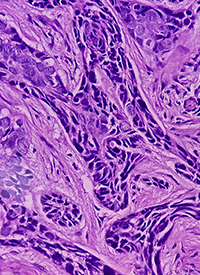DecisionDx-Melanoma 31-Gene Expression Profile Test Stratifies Patients With Cutaneous Melanoma
The DecisionDx-Melanoma 31-gene expression profile test displayed the capability to stratify patients with cutaneous melanoma by risk of death from the disease and receival of the 31-GEP test may result in a survival benefit compared with untested patients.

The DecisionDx-Melanoma 31-gene expression profile (31-GEP) test displayed the capability to stratify patients with cutaneous melanoma by risk of death from the disease and receival of the 31-GEP test may result in a survival benefit compared with untested patients, according to findings published in the Journal of Clinical Oncology.1
The validated GEP test classifies the risk of recurrence, metastasis, or death for patients with melanoma as either low (class 1A), intermediate (class 1B/2A), or high (class 2B).1 It is RT-PCR–based and usesformalin-fixed paraffin-embedded primary tumor tissue to determine which classification a given patient falls into based on expression of 31 genes.2
To conduct their population-based registry study, investigators pooled data from 17 of the National Cancer Institute’s SEER registries and identified patients with stage I to III cutaneous malignant melanoma with a clinical 31-GEP test result between 2016 and 2018 (n = 4687). The 3-year melanoma-specific survival (MSS) rate among all patients was 97.7% (95% CI, 97.1%-98.3%) and the 3-year overall survival (OS) rate was 92.8% (95% CI, 91.8%-93.8%).1
Patients who were determined by the 31-GEP to be of risk class 1A (n = 3174), class 1B/2A (n = 845), or class 2B (n = 668) achieved 3-year MSS rates of 99.7% (95% CI, 99.4%-100%), 97.1% (95% CI, 95.7%-98.6%), and 89.6% (95% CI, 86.3%-93.1%), respectively (P < .001). Additionally, the 3-year OS rates were 96.6% (95% CI, 95.7%-97.6%), 90.2% (95% CI, 87.7%-92.8%), and 79.4% (95% CI, 75.4%-83.6%), respectively (P < .001).1
Investigators excluded patients with stage IV disease, as the 31-GEP is not indicated for disease of this severity. Patients with a diagnosis or 31-GEP testing date before 2016 and those who were tested over 1 year after diagnosis were also excluded. Study authors accessed the SEER registries from Connecticut, Georgia, Greater California, Hawaii, Idaho, Iowa, Kentucky, Los Angeles, Louisiana, Massachusetts, New Mexico, New York, San Francisco/Greater Bay, Seattle-Puget Sound, and Utah.1
The median age of patients included in the registry study was 63 years (range, 13 to > 90). Most patients were men (55.7%), underwent nodal assessment (75.6%), were sentinel or regional node negative (69.8%), were White (91.2%), and had American Join Committee on Cancer (AJCC) 8th edition stage IA disease (58.9%). Common tumor locations included extremities (45.2%), head and neck (21.0%), and trunk (33.2%).1
The median Breslow thickness of included patients was 0.8 mm (range, 0.0-9.9) and T-stages were T1a (46.1%), T1b (17.3%), T2a (16.8%), T2b (4.1%), T3a (5.6%), T3b (4.2%), T4a (2.5%), and T4b (3.4%). Further, the study included patients who received a diagnosis in the years 2016 (24.8%), 2017 (33.2%), and 2018 (42.0%).1
Additional findings from a multivariable Cox regression analysis of the study showed that, using class 1A patients as a reference, categorization as class 1B/2A (HR, 4.86; 95% CI, 1.97-12.03) and class 2B (HR, 7.00; 95% CI, 2.70-18.00) were independent predictors of MSS. Moreover, using an absence of ulceration as a reference, having an ulceration (HR, 1.59; 95% CI, 0.86-2.94) and Breslow thickness (HR, 1.16; 95% CI, 1.05- 1.27) were independent predictors of MSS. Having a positive lymph node (HR, 2.64; 95% CI, 1.45-4.79) was an independent predictor of MSS with lymph node negativity as a reference.1
Regarding OS, independent predictors included having class 1B/2A (HR, 2.22; 95% CI, 1.51-3.25) and 2B disease (HR, 2.39; 95% CI, 1.54-3.70) with class 1A used as a reference. Age (HR, 1.08; 95% CI, 1.07-1.10) and having an ulceration present (HR, 1.45; 95% CI, 1.02-2.06) were independent predictors of OS as well.1
Investigators also performed a matching analysis comparing the survival of patients who underwent 31-GEP testing (n = 3258) with a sample of patients who did not receive the test (n = 9774). The median age of patients in both groups was 62 years and the median follow-up for both cohorts was 2 years (range, 0-4). Most patients in both arms were men (55.5% vs 55.2%), had lymph node negativity (72.2% vs 73.0%), were White (93.7% vs 93.9%), and had AJCC stage IA disease (55.0% vs 54.8%).1
Findings from the matching analysis showed that patients tested with the 31-GEP had a 29% lower risk for MSS mortality (HR, 0.71; 95% CI, 0.53-0.94) and a 17% lower risk for overall mortality (HR, 0.83; 95% CI, 0.70-0.99) compared with those who did not undergo testing. The 3-year MSS rates for 31-GEP tested patients and untested patients were 97.4% (95% CI, 96.6%-98.2%) vs 96.1% (95% CI, 95.5%-96.6%), respectively. Additionally, the 3-year OS rates were 92.4% (95% CI, 91.1%-93.6%) vs 90.90% (95% CI, 90.1%-91.7%), respectively.1
Study authors noted that their study was potentially limited by lack of SEER data concerning treatment and surveillance, follow-up time for some patients, and additional unknown variables that could affect survival. “The 31-GEP, which integrates tumor molecular characteristics into clinical decision making, can improve patient care by providing physicians with additional information to allow for more precise risk assessment to tailor treatment for individualized patient care. Integrating 31-GEP testing with current guidelines can help clinicians make risk-aligned management decisions, which may improve patient outcomes and could reduce the melanoma-associated burden on patients and the health care system,” they wrote in conclusion.1
References
- Bailey CN, Martin BJ, Petkov VI, et al. 31-gene expression profile testing in cutaneous melanoma and survival outcomes in a population-based analysis: a SEER collaboration. JCO Precis Oncol. Published online June 29, 2023. doi:10.1200/PO.23.00044
- Cook RW, Middlebrook B, Wilkinson J, et al. Analytic validity of DecisionDx-Melanoma, a gene expression profile test for determining metastatic risk in melanoma patients. Diagn Pathol. 2018;13(1):13. doi:10.1186/s13000-018-0690-3



